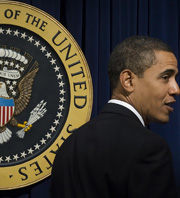Presidential Transparency
John Moe
Marc Sanchez
JANUARY 24, 2009
- President Barack Obama
- (Jim Watson/AFP/Getty Images)
- View the Slideshow
Web Resources
Related Stories
- Good News, Bad News, No News
- Spending the Stimulus Money
- Foreclosure Double Punch
- The End of Weekend America
More From John Moe
- Now you can draw state redistricting maps too
- The coming conundrum of home DNA testing
- What mattered this year in technology
More From Marc Sanchez
Transparency is a key issue of the new administration. President Obama wants to open the doors to government and shake free from the veil of secrecy that cloaked the previous administration. If you happened to be watching the official White House website this past Tuesday, say around noon, you might have seen transparency in action. Whitehouse.gov looks and feels different. You kind of get the feeling that it might be a place to go and hang out, share ideas and learn a few things. Michael Cornfield is Vice President for Research and Media Strategy at 720 Strategies, a Washington, D.C.-based "public persuasion firm" specializing in integrated communications - online, on video and in print. We called on him to help unpack the revamped site.
---
John Moe: What was the difference between WhiteHouse.gov between Monday and Tuesday? How are those two different sites?
Cornfield: Well, it went to "Barack Obama Blue," which will be an official color very soon. You can tell instantly by looking at it that there's someone new in charge and they're tech-savvy.
Moe: What are they doing, especially in terms of transparency?
Cornfield: There's an open government directive due in 120 days from the Office of Management and Budget, and from the new technology office. The word has gone forth from President Obama and the White House to all executive departments and agencies that decisions are to be made and published online instantly. And operations are to be made visible - more visible than they were before. One way of looking at this is that the Obama administration has declared that "openness is the new default setting" of this government. So from darkness to sunlight, or at least sky blue, Obama Blue.
Moe: When you're at the whitehouse.gov website, do you see transparency in government already in place? Do you see fake transparency? What is the status of transparency when you look at that site of our new president?
Cornfield: I don't see "fake" and I don't see "real." What I see are aspirations. And I think the big danger here is not that the Obama campaign is going to set up a Potemkin site and mislead us, it's more that they're going to set expectations higher than can be fulfilled.
When you're asking people to participate in healthcare policy, for example, are you going to ask them to say what the Medicare reimbursement rate should be? And if you do, are you going to give them a slider? Are you going to say, "Here's from zero to 100 percent. Move the slider to where you think the reimbursement rate ought to be." These are much more difficult decisions. How do you aggregate them? How do you discriminate among those that were casually clicked through versus serious ones?
Moe: If we stipulate that he is in office in large part because he mobilized things and people and forces and energy online so efficiently, does the success of his administration depend on being able to harness that energy and turn it into something else and not let it dissipate?
Cornfield: To an unprecedented degree, it does. But it also depends on offline politics, if you will. It's kind of hard to say anything less sweeping and less abstract than that. I can hear you sighing as I swirl these concepts around. But really, we've never been here before. We really don't know what participatory government would look like before the Internet. We've never had a community organizer win the presidency. Although I have to say that, if the campaign is any illustration, they are rigorously faithful to the plans and the pathways that they set out for themselves. They're very, very disciplined.
Moe: It's worth bookmarking. It's worth following.
Cornfield: That's a very good way to put it.
Moe: Michael Cornfield, thank you so much.
Cornfield: Thank you for having me.
-
- Music Bridge:
- Beams
- Artist: Tape
- CD: Luminarium (Hapna Sweden)







Comments
Comment | Refresh
From Town, IN, 06/17/2010
Hello John, I am satisfied and not against AEJMC making a statement. This a great thing about Obama, he puts the most brilliant minds our nation and to offer to work on its most important problems.
Post a Comment: Please be civil, brief and relevant.
Email addresses are never displayed, but they are required to confirm your comments. All comments are moderated. Weekend America reserves the right to edit any comments on this site and to read them on the air if they are extra-interesting. Please read the Comment Guidelines before posting.
You must be 13 or over to submit information to American Public Media. The information entered into this form will not be used to send unsolicited email and will not be sold to a third party. For more information see Terms and Conditions and Privacy Policy.